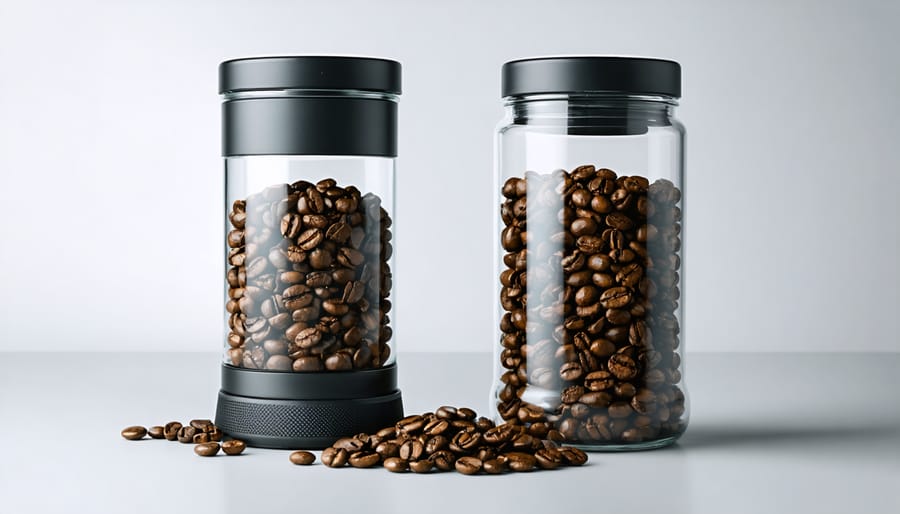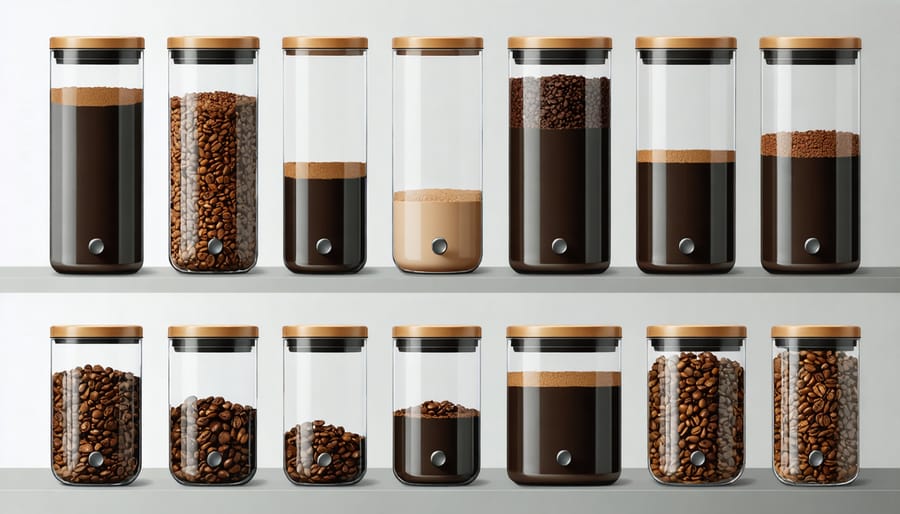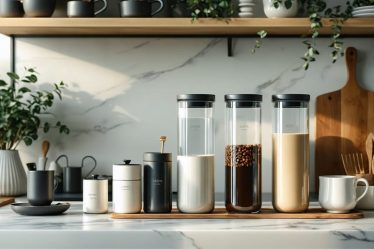
Picture your favorite coffee beans – those perfectly roasted, aromatic gems that make your morning brew absolutely magical. Now imagine preserving that same fresh-roasted excellence for months to come. As a fellow coffee lover who’s learned through countless experiments (and yes, a few disappointments), I’m here to share the secrets of keeping your precious beans at their peak flavor. Whether you’ve just scored an amazing deal on your favorite single-origin beans or simply want to maintain your coffee’s quality longer than usual, proper storage isn’t just about finding any airtight container – it’s about creating the perfect environment that protects those complex flavors and subtle notes you love. In the next few minutes, you’ll discover exactly how to shield your beans from their four biggest enemies: air, moisture, heat, and light, ensuring every cup tastes as remarkable as the day you brought those beans home.
Why Proper Storage Makes or Breaks Your Coffee Experience
The Science Behind Coffee Freshness
Ever wondered why your morning brew sometimes tastes different? The science behind keeping coffee beans fresh is fascinating! Just like how a sliced apple turns brown, coffee beans undergo oxidation when exposed to air. This natural process breaks down the oils and compounds that give your coffee its delicious flavor and aroma. Think of it as your beans slowly losing their magic!
Moisture is another sneaky culprit – it can make your beans lose their crunch and invite unwanted mold (yuck!). And temperature? It’s like a time machine for your coffee. Warm environments speed up the aging process, while cooler temps help preserve those precious flavors we all love. That’s why proper storage isn’t just about having a pretty container – it’s about protecting your beans from these three coffee-quality thieves!
Common Storage Mistakes to Avoid
Let me share a coffee storage confession: I once stored my precious beans in a clear glass jar on my sunny kitchen windowsill – a rookie mistake we’ve all made! To keep your coffee beans fresh and flavorful, avoid these common storage slip-ups. Never keep beans in the original packaging once opened, as those thin bags don’t protect against air and moisture. Skip storing beans in the fridge or freezer for daily use; the temperature fluctuations create condensation that can ruin your beans. Another no-no is using decorative containers that aren’t airtight – no matter how cute they look on your counter! Also, resist the urge to buy bulk amounts that you won’t use within a month, as even perfectly stored coffee gradually loses its magic. Remember, coffee beans are like little flavor sponges, so keep them away from strong-smelling foods and spices that can affect their taste.


Essential Storage Containers and Tools
Airtight vs. Vacuum-Sealed Containers
When it comes to storing coffee beans, I’ve learned through trial and error that not all containers are created equal. While both airtight and vacuum-sealed containers can work well as sustainable kitchen storage solutions, they each have their unique benefits.
Airtight containers are the more common choice, featuring a simple seal that keeps air out when closed. They’re perfect for daily coffee drinkers who access their beans frequently, and they’re typically more budget-friendly. I love using these for my weekly coffee supply since they’re easy to open and close multiple times a day.
Vacuum-sealed containers take preservation a step further by removing all air from the container, creating an environment where coffee beans can’t oxidize. While they’re a bit pricier, they’re ideal for storing larger quantities of beans or for those special reserve beans you’re saving for special occasions. Many coffee enthusiasts I know swear by vacuum-sealed containers for maintaining that fresh-roasted flavor for months.
Choose based on your coffee habits – if you’re a daily brewer, an airtight container works wonderfully. For longer storage or premium beans, consider investing in a vacuum-sealed option.
The Role of One-Way Valves
Ever wonder why those fancy coffee bags have that little circular valve on them? Let me share a fascinating coffee secret: freshly roasted coffee beans actually “breathe!” After roasting, beans release carbon dioxide gas for several days – a process we coffee lovers call degassing. This is completely natural and actually a sign of fresh beans.
Here’s where one-way valves become our coffee-storing superheroes. These clever little devices allow the carbon dioxide to escape while preventing oxygen from getting in. Without these valves, your storage containers could build up pressure from the trapped gas, potentially causing the bag to burst (trust me, I learned this the hard way with a sealed mason jar!).
When choosing storage containers for your beans, look for those with built-in one-way valves. They’re especially important if you’re buying freshly roasted beans or storing large quantities. Think of these valves as tiny bodyguards, protecting your precious beans while letting them release their post-roasting gases naturally. It’s a small detail that makes a big difference in maintaining your coffee’s freshness and flavor.
Perfect Storage Conditions

Temperature Control
Think of your coffee beans like a delicate flower – they need just the right temperature to thrive! To maximize coffee flavor, keep your beans between 68-77°F (20-25°C). I learned this the hard way after storing my precious Brazilian beans near a sunny window – trust me, you don’t want to make the same mistake!
Avoid temperature fluctuations at all costs, as they can cause condensation inside your storage container, potentially leading to mold growth. The freezer might seem like a good option, but I’d only recommend it for truly long-term storage (think months, not weeks). If you do freeze your beans, store them in an airtight container and never return thawed beans to the freezer.
Your kitchen counter might be convenient, but if it’s near the stove or receives direct sunlight, consider finding a cooler spot in your pantry instead. A consistent, room-temperature environment is your best bet for keeping those aromatic oils intact.
Humidity Management
Let me share something I learned the hard way – humidity is your coffee beans’ sneaky enemy! Just like we feel uncomfortable on sticky, humid days, coffee beans can’t stand excess moisture either. Think of your beans as tiny flavor sponges; they’ll absorb moisture from the air, which can lead to mold growth and flavor deterioration.
The sweet spot for storing coffee beans is in an environment with 11-13% humidity. I know this might sound specific, but don’t worry – you don’t need to become a humidity expert! The key is keeping your beans away from moisture-heavy areas like above your stove, near the dishwasher, or on countertops that tend to get splashed.
Here’s my go-to tip: store your beans in an airtight container with a one-way valve in a cool, dry pantry. If you live in a particularly humid climate (hello, fellow coastal dwellers!), consider using food-grade silica gel packets in your storage container. They work wonders in absorbing excess moisture without affecting your coffee’s flavor. Just remember to replace them every few months to maintain their effectiveness.
Light Exposure Prevention
Remember that one sunny morning when you left your coffee bag on the kitchen counter, right in the bright morning light? I learned this lesson the hard way too! Light exposure is actually one of the biggest enemies of fresh coffee beans, and here’s why: those precious beans contain oils that react with both natural and artificial light, leading to faster degradation of flavor and aroma.
Think of your coffee beans like a vampire – they truly thrive in darkness! To protect your beans from harmful light exposure, always store them in opaque containers. While those glass jars might look Instagram-worthy on your counter, they’re not doing your coffee any favors. If you absolutely love the look of clear containers, try wrapping them in a cute tea towel or storing them in a cabinet.
For those of us who buy in bulk, consider dividing your beans into smaller portions. Keep your main stash in a light-proof container tucked away in a dark pantry, and only bring out a week’s worth at a time in your everyday container. This way, the majority of your beans stay protected while you still have easy access to your daily coffee fix!
Long-Term Storage Solutions
Freezing Do’s and Don’ts
Let me share a game-changing discovery from my coffee journey – freezing coffee beans can actually be a fantastic way to preserve them! But just like that time I carelessly tossed a bag of beans in the freezer (rookie mistake!), there are some important rules to follow.
First, always portion your beans into small, airtight containers or freezer bags. You’ll want to use only what you need without repeatedly exposing the frozen beans to room temperature. I learned this the hard way when I kept opening and closing a large container, only to end up with moisture-damaged beans.
Do vacuum seal your portions if possible – it’s the best protection against freezer burn. Don’t forget to label each package with the date and bean type. When you’re ready to use them, move your portioned beans directly from the freezer to your grinder – never let them thaw first.
Here’s a crucial don’t: avoid storing beans in paper bags or standard storage containers in the freezer. These aren’t moisture-proof and can lead to condensation issues. Also, keep your frozen beans away from strong-smelling foods – coffee loves to absorb nearby odors!
Remember, once you’ve thawed your beans, don’t refreeze them. Think of it as a one-way trip from freezer to cup!
Bulk Storage Strategies
When I first started buying coffee in bulk (hello, amazing warehouse deals!), I quickly learned that proper storage is crucial for maintaining those delicious flavors. For larger quantities of coffee beans, I recommend investing in multiple airtight containers rather than one huge vessel. This approach lets you keep most of your beans sealed while having a smaller portion ready for daily use.
Food-grade buckets with gamma seal lids work wonderfully for storing larger amounts – they’re my go-to for those big coffee hauls. Just make sure to add a few oxygen absorbers to each container before sealing. If you’re super serious about preservation, consider vacuum-sealing portions of your beans in smaller bags, which you can then store in a larger container.
Remember to label everything with purchase dates and roast types. I learned this the hard way after mixing up my medium and dark roasts! Keep your bulk storage in a cool, dark place like a pantry or basement, away from heat sources and direct sunlight. For the best results, only open one container at a time, leaving the others perfectly sealed until needed.
As a fellow coffee lover, I’ve learned that proper storage is truly the key to maintaining those delightful coffee moments we all cherish. By following these simple yet effective storage practices – keeping beans in an airtight container, away from light, heat, and moisture, and storing them in a cool, dark place – you can significantly extend the life of your precious coffee beans.
Remember, while freezing can be an option for long-term storage, it’s best reserved for bulk purchases you won’t use within a month. Whatever storage method you choose, the most important thing is consistency and attention to detail. Think of your coffee beans as the treasure they are – worthy of a little extra care and consideration.
I encourage you to take these storage tips and make them part of your coffee routine. Your future self will thank you when you’re brewing that perfect cup of coffee months down the line, still tasting all those complex flavors and aromas as if you’d just brought the beans home from your favorite roaster. Here’s to many more delicious coffee moments ahead!



